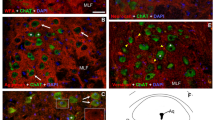Abstract
In previous studies, chondroitin sulfate proteoglycans have been localized to the periphery of the zonular fibers and the individual zonular fibrils (or microfibrils) after Cuprolinic blue staining in conjunction with chondroitinase digestions and immunogold labelling with 2-B-6 antibody. In the present study, we wished to determine if these proteoglycans are linked to hyaluronan to form a large multimolecular aggregate. To accomplish this, we localized the hyaluronan using a biotinylated hyaluronan-binding protein fragment of chondroitin sulfate proteoglycan, containing also the link protein, purified from bovine nasal cartilage. The results showed that the ciliary zonule of the rat eye was reactive with the biotinylated hyaluronan-binding probe as demonstrated by streptavidin-peroxidase-diaminobenzidine staining and streptavidin-gold labelling. Hyaluronan-gold labelling showed that the gold particles were mostly localized on the periphery of the zonular fibers, which was similar to the localization pattern of the zonule associated-proteoglycans. This hyaluronan-binding probe also strongly labelled the sites of zonule insertion over the basement membrane of the inner ciliary epithelium at the pars plana and the lens capsule at the equatorial region, which suggests its probable role in the attachment of ciliary zonule to the basement membranes. To demonstrate whether these two molecules are linked to one another, ultrastructural colocalization of both hyaluronan and chondroitin sulfate proteoglycans was performed on the same sections by double-gold labelling, and combined Cuprolinic blue staining and hyaluronan-gold labelling. Gold particles of 15 and 10 nm in sizes labelling both hyaluronan and chondroitin 4-sulfate, were colocalized to the surface of the zonular fibers. The combined Cuprolinic blue staining and hyaluronan-gold labelling showed that the gold particles were localized towards the ends of the Cuprolinic blue-stained rodlets, which strongly suggests that these chondroitin sulfate proteoglycans are linked to the hyaluronan chain to form a large aggregate surrounding the periphery of the zonular fibers. These ciliary zonule-associated proteoglycan-hyaluronan aggregates may play a role in organizing the individual zonular fibrils (microfibrils) into bundles of zonular fibers.
Similar content being viewed by others
Author information
Authors and Affiliations
Additional information
Accepted: 5 November 1996
Rights and permissions
About this article
Cite this article
Chan, F., Choi, H. & Underhill, C. Hyaluronan and chondroitin sulfate proteoglycans are colocalized to the ciliary zonule of the rat eye: a histochemical and immunocytochemical study. Histochemistry 107, 289–301 (1997). https://doi.org/10.1007/s004180050114
Issue Date:
DOI: https://doi.org/10.1007/s004180050114




